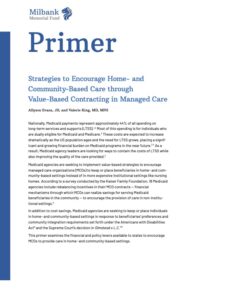 Nationally, Medicaid payments represent approximately 44% of all spending on long-term services and supports (LTSS).1,2 Most of this spending is for individuals who are dually eligible for Medicaid and Medicare.3 These costs are expected to increase dramatically as the US population ages and the need for LTSS grows, placing a significant and growing financial burden on Medicaid programs in the near future.2,4 As a result, Medicaid agency leaders are looking for ways to contain the costs of LTSS while also improving the quality of the care provided. 2 Medicaid agencies are seeking to implement value-based strategies to encourage managed care organizations (MCOs) to keep or place beneficiaries in-home and community-based settings instead of in more expensive institutional settings like nursing homes.
Nationally, Medicaid payments represent approximately 44% of all spending on long-term services and supports (LTSS).1,2 Most of this spending is for individuals who are dually eligible for Medicaid and Medicare.3 These costs are expected to increase dramatically as the US population ages and the need for LTSS grows, placing a significant and growing financial burden on Medicaid programs in the near future.2,4 As a result, Medicaid agency leaders are looking for ways to contain the costs of LTSS while also improving the quality of the care provided. 2 Medicaid agencies are seeking to implement value-based strategies to encourage managed care organizations (MCOs) to keep or place beneficiaries in-home and community-based settings instead of in more expensive institutional settings like nursing homes.
According to a survey conducted by the Kaiser Family Foundation, 18 Medicaid agencies include rebalancing incentives in their MCO contracts — financial mechanisms through which MCOs can realize savings for serving Medicaid beneficiaries in the community — to encourage the provision of care in non-institutional settings. 5 In addition to cost savings, Medicaid agencies are seeking to keep or place individuals in-home and community-based settings in response to beneficiaries’ preferences and community integration requirements set forth under the Americans with Disabilities Act 6 and the Supreme Court’s decision in Olmstead v L.C.7
This primer examines the financial and policy levers available to states to encourage MCOs to provide care in-home and community-based settings.


